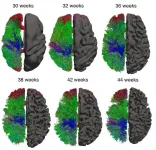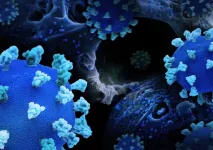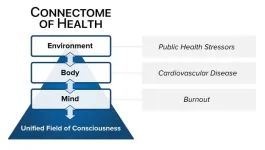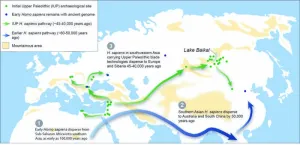(Press-News.org) How similar are dinosaurs to modern birds? This question is at the heart of a new study that examined how proteins found in dinosaur feathers changed over millions of years and under extreme heat.
Previous studies suggest that dinosaur feathers contained proteins that made them less stiff than modern bird feathers. Now, researchers with University College Cork (UCC), the Stanford Synchrotron Radiation Light Source (SSRL) at the Department of Energy's SLAC National Accelerator Laboratory and other institutions have discovered that dinosaur feathers originally had a very similar protein composition to those of modern birds. That result means that today’s bird feather chemistry likely originated much earlier than previously thought, perhaps as early as 125 million years ago.
“It’s really exciting to discover new similarities between dinosaurs and birds,” said Tiffany Slater, a paleontologist at UCC and lead author on the new study. “Using X-rays and infrared light, we found that feathers from the dinosaur Sinornithosaurus contained lots of beta-proteins, just like feathers of birds today. This finding validates our hypothesis that dinosaur birds had stiff feathers – like in modern birds.”
The crux of the issue is the protein mix. Earlier tests on dinosaur feathers found mostly alpha-keratin proteins, which result in less stiff feathers, whereas modern bird feathers are rich in beta-keratin proteins, which strengthen feathers for flight. Still, the researchers wondered whether that difference reflected the real chemistry of the feathers during life or an artifact of the fossilization process.
To find out, Slater and fellow UCC paleontologist Maria McNamara teamed with SSRL scientists to analyze 125-million-year-old feathers from the dinosaur Sinornithosaurus and the early bird Confuciusornis, plus a 50-million-year-old feather from the U.S. They published their results today in Nature Ecology and Evolution.
To detect the proteins in the ancient feathers, researchers placed the fossils in front of SSRL’s powerful X-rays, which revealed whether key components of beta-proteins were present. This helped the researchers determine if a sample’s beta-proteins were still in their “native” form or if they had altered over time – and how that alteration proceeds chemically, SSRL scientist Sam Webb said.
The team also performed separate experiments that simulate the temperatures that the fossils are subjected to over time, Webb said. These experiments showed that alpha-proteins can form in a fossil due to the fossilization process, rather than being part of the feather during life.
The analysis showed that while some fossil feathers contain lots of alpha-proteins, they were likely not there originally, but instead formed over time. They formed due to the high extreme heat that fossils experience.
“Our experiments help explain that this weird chemical discrepancy is the result of protein degradation during the fossilization process,” Slater said. “So although some dinosaur feathers do preserve traces of the original beta-proteins, other fossil feathers contain alpha-proteins that formed during fossilization.”
“The idea that original protein compositions may change over time is an often overlooked aspect of looking at biomarkers from deep time,” Webb said. “Comparing our X-ray spectroscopy results to the additional lab measurements of experimentally heated feather samples helped calibrate our findings.”
"Traces of ancient biomolecules can clearly survive for millions of years, but you can’t read the fossil record literally because even seemingly well-preserved fossil tissues have been cooked and squashed during fossilization," said Maria McNamara, senior author on the study.
“We’re developing new tools to understand what happens during fossilization and unlock the chemical secrets of fossils," McNamara said. "This will give us exciting new insights into evolution.”
This article is based on a press release from University College Cork.
END
Dinosaur feathers contain traces of ancient proteins, study finds
Powerful X-rays generated at SLAC National Accelerator Laboratory help researchers shed new light on feather evolution.
2023-09-22
ELSE PRESS RELEASES FROM THIS DATE:
Q&A: How new software is changing our understanding of human brain development
2023-09-22
A single brain is unfathomably complex. So brain researchers, whether they’re looking at datasets built from 300,000 neurons in 81 mice or from MRIs of 1,200 young adults, are now dealing with so much information that they must also come up with new methods to comprehend it. Developing new analysis tools has become as important as using them to understand brain health and development.
A team including researchers at the University of Washington recently used new software to compare MRIs from 300 babies and discovered that myelin, a part of the brain’s so-called white matter, develops much slower after birth. The researchers published their findings Aug. ...
Clinical trial to test immune modulation strategy for hospitalized COVID-19 patients begins
2023-09-22
A clinical trial has launched to test whether early intensive immune modulation for hospitalized COVID-19 patients with relatively mild illness is beneficial. The placebo-controlled study, part of the global clinical trials consortium known as Strategies and Treatments for Respiratory Infections and Viral Emergencies (STRIVE), will enroll approximately 1,500 people at research sites around the world. It is supported by the National Institutes of Health’s National Institute of Allergy and Infectious Diseases (NIAID) in partnership with NIH’s National Center for Advancing Translational Sciences (NCATS).
Immune ...
Five factors that assess well-being of science predict support for increasing US science funding
2023-09-22
PHILADELPHIA – A study in the Proceedings of the National Academy of Sciences (PNAS) identifies five factors that Annenberg Public Policy Center (APPC) researchers say reflect public assessments of science and are associated with public support for increasing funding of science and support for federal funding of basic research. These factors are whether science and scientists are perceived to be credible and prudent, and whether their work is perceived to be untainted by bias, self-correcting, and beneficial.
Drawing on 13 questions in APPC’s 2022 nationally representative ...
Editorial addresses clinician burnout with unifying systems medicine model
2023-09-22
A new editorial published in the Heart and Mind journal proposes an innovative systems medicine approach to address the epidemic of clinician burnout and holistically improve clinician mental health and wellbeing (Heart and Mind: September 18, 2023. | DOI: 10.4103/hm.HM-D-23-00013, published ahead of print).
In the US and globally, clinician burnout has reached epidemic levels, with over 50% of physicians and healthcare providers reporting symptoms. Besides impairing quality of life, burnout increases risk of mental health disorders, cardiovascular disease and impaired ...
Pollen analysis suggests peopling of Siberia and Europe by modern humans occurred during a major Pleistocene warming spell
2023-09-22
LAWRENCE — It’s an Ice Age mystery that’s been debated for decades among anthropologists: Exactly when and how did the flow of Homo sapiens in Eurasia happen? Did a cold snap or a warming spell drive early human movement from Africa into Europe and Asia?
A new study appearing in Science Advances compares Pleistocene vegetation communities around Lake Baikal in Siberia, Russia, to the oldest archeological traces of Homo sapiens in the region. The researchers use the “remarkable evidence” to tell a compelling story from 45,000-50,000 years ago with new detail: how the first humans migrated across ...
Many low- or middle-income countries unprepared for the battle against cardiovascular disease
2023-09-22
Most healthcare facilities in many Low- and Middle-income Countries (LMICs) are unprepared to treat patients with cardiovascular diseases – despite these conditions leading to millions of people dying prematurely every year, a new study reveals.
Experts analysed health survey data from eight LMICs across four World Health Organisation world regions to discover that most facilities are unprepared to deliver services to treat or manage cardiovascular disease risk factors (CVDRF) such as diabetes and hypertension.
However, the increased ...
Probing the deep genetic structure of Africa
2023-09-22
Africa is the birthplace of modern humans and the continent with the highest level of genetic diversity. While ancient DNA studies are revealing some aspects of the genetic structure of Africa before the spread of food production, issues concerning DNA preservation have limited the insights from ancient DNA. Hoping to find clues in modern populations, researchers from a Portuguese-Angolan TwinLab ventured into the Angolan Namib desert – a remote, multi-ethnic region where different traditions met. “We were able to locate groups which were thought to have disappeared more than 50 years ago”, states Jorge ...
UC San Diego Health named national leader in delivering high-quality patient care
2023-09-22
UC San Diego Health has been recognized as a top performer in the 2023 Bernard A. Birnbaum, MD, Quality Leadership Ranking by Vizient, Inc. for its excellence in delivering high-quality patient care. This achievement represents the fifth consecutive year that UC San Diego Health has been ranked among the top ten academic health systems in the United States.
“This incredible accomplishment is a direct result of the exceptional care provided each day by our multidisciplinary teams throughout our health system,” said Patty Maysent, CEO of UC San Diego Health. “We are extremely proud to have achieved this national honor now for five years in a row, which ...
Louisiana Cancer Research Center Associate Director of Administration Sven Davisson named Treasurer of Association of Independent Research Institutes
2023-09-22
Louisiana Cancer Research Center (LCRC) Associate Director of Administration Sven Davisson has been appointed to the board of the Association of Independent Research Institutes (AIRI).
During his two-year term, Davisson will serve as the organization’s treasurer. He has served the organization in various roles since 2012.
AIRI is a national association of independent, not-for-profit biomedical and behavioral research institutes whose mission is to enhance the ability of its members to improve human health and advance knowledge through networking, education, and involvement in the development of science ...
Discovery in mosquitoes could lead to new strategy against dengue fever and other mosquito-borne vectors
2023-09-22
Researchers from the Johns Hopkins Malaria Research Institute at the Johns Hopkins Bloomberg School of Public Health have made an important finding about Aedes aegypti mosquitoes—one that could one day lead to better methods for reducing the mosquito-to-human transmission of dengue, yellow fever, Zika, and other harmful and sometimes deadly viruses.
Ae. aegypti mosquitoes do not succumb to these viruses when infected and continue to move and feed normally. As such, the ...
LAST 30 PRESS RELEASES:
A bacterial toxin can counteract colorectal cancer growth
Frozen hydrogen cyanide ‘cobwebs’ offer clues to origin of life
Physics of foam strangely resembles AI training
Bis-pseudoindoxyls: a new class of single benzene-based fluorophores for bioimaging applications
Blocking a cancer-related pathway helps reduce spine deformities due to genetic disorder, finds new study
New study explores therapeutic potential of CRISPRCas3 genome-editing system
Korea University researchers revive an abandoned depression drug target using structurally novel NK1 receptor inhibitors
Jeonbuk National University researchers highlight advancements in chemical looping fluidized bed reactors
Tyrannosaurus rex grew up slowly: New study reveals the “king of dinosaurs” kept growing until age 40
Commercial water dispenser machines may contain more contamination than tap water
Death and doctors: New WSU study looks at medical student education on end-of-life care
The best hydrogen for heavy-duty transport is locally produced and green
Pregnancy-related high blood pressure varied among Asian, Pacific Islander subgroups
Measuring movement creates new way to map indoor air pollution
Europe’s crop droughts to get worse even as rain increases
New study identifies signature in blood to better predict type 2 diabetes risk
Research spotlight: developing “smart” nanoparticles to deliver targeted gene therapy in osteoarthritis
A CRISPR fingerprint of pathogenic C. auris fungi
Time warp: How marketers express time can affect what consumers buy
CBD treatment reverses key effects of fetal alcohol spectrum disorder in a mouse model
Blood sugar spikes linked to higher risk of Alzheimer's disease
Staying single for longer affects young people’s well-being
New method allows scientists to 3D-print structures within cells
Screening tool helps identify brain-related comorbidities in individuals with Duchenne muscular dystrophy
How do the active ingredients of monkfruit affect health?
News language and social networks: how do they affect the spread of immigration attitudes?
Researchers discover trigger of tendon disease
Your pet's flea treatment could be destroying the planet
Diabetes risk not associated with timing or type of menopause
Bulk inorganic crystals grown from water emit “handed” light
[Press-News.org] Dinosaur feathers contain traces of ancient proteins, study findsPowerful X-rays generated at SLAC National Accelerator Laboratory help researchers shed new light on feather evolution.






